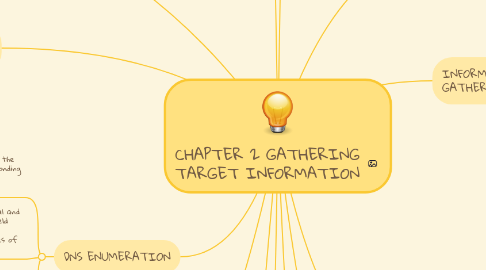
1. INFORMATION GATHERING METHODOLOGY
1.1. unearth initial information
1.1.1. is the act of footprinting basic usually free available, information about a target.
1.2. locate the network range
1.2.1. neotrace and visual route
1.3. certain active machines
1.3.1. port scanner
1.3.2. detect os (telnet)
1.4. discover open ports/ access ports
1.4.1. a potential target computer runs many services
1.5. detect operating system
1.5.1. active banner grabbing
1.5.2. passive banner grabbing
1.5.3. tool: netcraf and telnet
1.6. uncover service on port
1.6.1. service running on specific port
1.7. mapping the network
1.7.1. manual mapping
1.7.2. automated mapping
2. DNS ENUMERATION
2.1. Is the process of locating all the DNS servers and their corresponding records for an organization.
2.2. A company may have both internal and external DNS servers that can yield information such as usernames, computer names, and IP addresses of potential target systems.
2.3. Tools to gain information
2.3.1. NSlookup
2.3.2. DNSstuff
2.3.3. American Registry for Internet Numbers (ARIN)
2.3.4. Whois
3. FOOTPRINTING USING GOOGLE HACKING TECHNIQUE
3.1. query string
3.2. vulnerability sites
3.3. google operators
4. WHAT A HACKER CAN DO WITH GOOGLE HACKING?
4.1. Advisories and server vulnerabilities
4.2. error messages that contain sensitive information
4.3. files containing passwords
4.4. sensitive directories
4.5. pages containing logon portals
4.6. pages containing network or vulnerability data
5. GOOGLE ANDVANCE SEARCH OPERATOR
5.1. site
5.2. file type
5.3. cache
5.4. link
5.5. intitle
5.6. inurl
6. SOCIAL ENGINEERING
6.1. is a nontechnical method of breaking into a system or network.
6.2. It’s the process of deceiving users of a system and convincing them to give out information that can be used to defeat or bypass security mechanisms.
6.3. HUMAN-BASED SOCIAL ENGINEERING
6.3.1. refers to person-to-person interaction to retrieve the desired information. An example is calling the help desk and trying to find out a password.
6.3.2. impersonate as important user.
6.3.3. pose as third person
6.3.4. call technical support
6.3.5. shoulder surfing
6.3.6. dumpster diving
6.4. COMPUTER-BASED SOCIAL ENGINEERING
6.4.1. refers to having computer software that attempts to retrieve the desired information. An example is sending a user an e-mail and asking them to reenter a password in a web page to confirm it. This social-engineering attack is also known as phishing.
6.4.2. computer based social engineering include the following
6.4.2.1. email attachments
6.4.2.2. fake website
6.4.2.3. pop up windows
6.4.3. Insider attacks
6.4.4. Identity theft
6.4.5. Phishing attacks
6.4.6. Online scams
6.4.7. Url obfuscation

